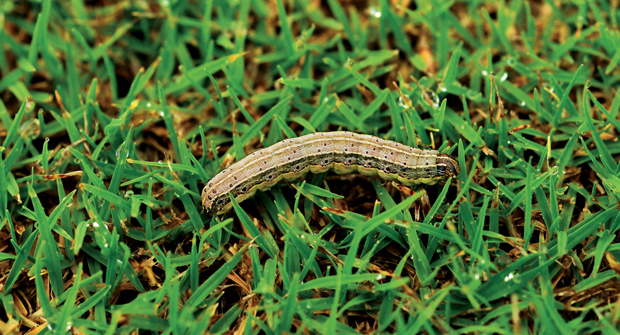A turf pest more associated with the Deep South and Mid-Atlantic attacked lawns in the Upper Midwest and Northeast. Fall armyworms, likely carried by summer storms, damaged turf in unlikely locations and Extension agents as far west as Iowa warned residents of possible outbreaks.

“This year it is a monstrous outbreak,” says Curtis Young, Ph.D., an Ohio State University Extension educator.
Mark Conklin, owner of TeamTurf in Erie, Pa., took the outbreak personally.
“My own lawn got hit. It was one of the early ones,” Conklin says. “It was a new lawn, just this spring, and it looked rough. It’s coming back, but it’s not to where it was. There are some patches that aren’t coming back.”
Conklin adds that in his 32 years of providing lawn care in Pennsylvania, he’s never encountered a fall armyworm and has been amazed at how quickly they decimated lawns.
Maddie Hester, office administrator for Grounds Services in Waterville, Ohio, near the Michigan and Indiana state lines, says the outbreak has been extreme in Ohio, especially along the Maumee River that runs through Toledo.
“We’re seeing it everywhere — not in Michigan so much, and we service a lot of homes up there — but definitely around Toledo and south,” Hester says.
Young says Ohio typically sees minor problems from the pest, but fall armyworms hit more areas this year.
“The whole state of Ohio seems to be experiencing a major outbreak of the fall armyworm, from south to north and east to west,” Young says.
Treatment and what’s next
TeamTurf treated lawns in Northeast Pennsylvania with bifenthrin and told homeowners to keep damaged lawns watered on warm, sunny days as fall armyworms attack leaves, not roots. So, healthy lawns with deeply rooted grass should recover. Conklin says the extra damage at his house is likely due to the tender age of his grass.
Lawn care companies also reached out to customers to inform them about the problem, give them warning signs to watch for and encourage them to contact them at the first sign of infestation.
Most customers are pretty understanding about why their lawns are being attacked, Conklin says.
“It’s everywhere, so they know it’s not one company that didn’t do something,” he says.
Several landscaping companies say pretreating lawns with chlorantraniliprole — which they typically use for grubs — prevented fall armyworm damage. Syngenta Communications Lead Mark LaFleur says the chemical can provide months of protection when applied early, but its use is not as common in the North.
“Preventive solutions are always the best,” LaFleur says. He adds that Syngenta has launched smaller packages, making chlorantraniliprole more affordable to smaller companies.
Conklin says he may add chlorantraniliprole for spring lawn treatments if it looks like fall armyworm outbreaks are going to become common in Pennsylvania.
“We’re going to have to sit down at the end of the season and figure out next year,” Conklin says. “This may be a once-in-a-50-year thing, or it could be every year. We’re going to have to figure that out.”
Young says entomologists will keep an eye out for fall armyworms in northern climates in 2022 but says the outbreak may not repeat itself. Armyworms can’t overwinter in cold climates. The first frost of the year will likely kill caterpillars, larvae and any adult moths.
He blames a larger-than-normal outbreak in the South this year and an active storm season that brought many adult caterpillars north for the Midwestern and Northeastern outbreak. Future northern outbreaks would again depend on weather and growing conditions in the South.

